Woolpaca:

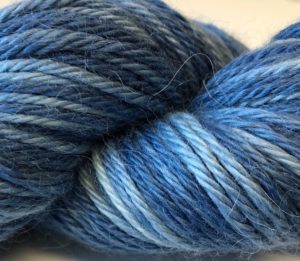
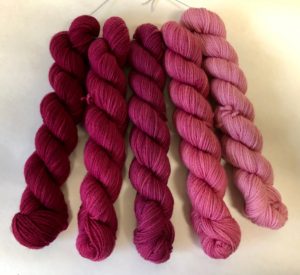
- 50% superfine alpaca, 50% wool
- Guage: 4 stitches to 1″ on US 8
- Comes in solid, semi-solid, multi-colored hanks, and gradient sets
Meritime:

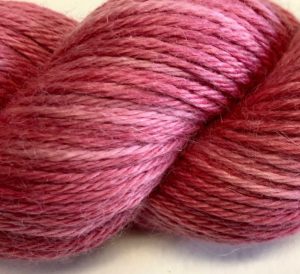

- 50% merino wool, 50% seacell
- Guage: 4 stitches to 1″ on US 8
- Comes in solid, semi-solid, multi-colored hanks, and gradient sets
UPDATE:
I can no longer get this yarn. 🙁 So when it’s gone, it’s gone.
Fingering Yarn:
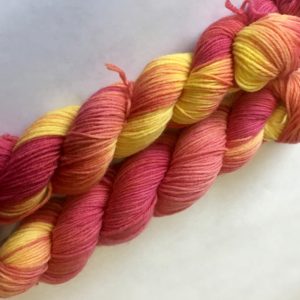
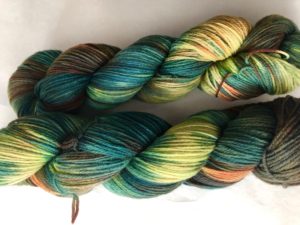
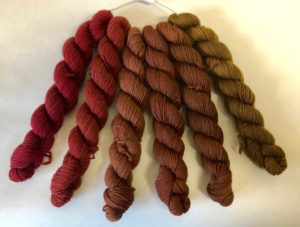
- 80% superwash wool, 20% Nylon
- Guage: 7 stitches to 1″ on US 3
- Comes in playful pairs, playful pairs plus, and gradient sets
Alpaca-Silk:
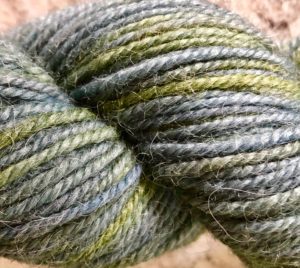

- 80% Alpaca, 20% Silk
- Guage: 5.5 stitches to 1″ on size 6
- Comes in semi-solid hanks and gradient sets
UPDATE:
I had high hope for this base, but it was phased out quickly, so also with this yarn, when it’s gone, it’s gone!
The first yarn I picked out to dye with in 2011 (when I worked for Osborn Fiber Studio) was the Woolpaca. I continue to enjoy this yarn. It is soft and sturdy, and takes the natural dye very well. It is cheaper than the Meritime because the blanks are cheaper for me to buy. The Meritime is also more expensive because it often takes more dye material to get the same, intense colors. I began using the Meritime yarn a year later because I wanted to have two bases. It is extremely soft and very wearable next to the skin. It is also has a beautiful sheen similar to yarns with silk in them. But no animal was used in this yarn; seacell is a plant product.
When I began ColorStorms in 2014, I changed the pricing system. I decided that I wanted the prices to better reflect how much or how little work went into each color. For example, pokeberries are difficult to work with because I have to pick them by hand and it’s a time-consuming process. So is working with apple bark, indigo and madder root. Thus they are more expensive yarns. On the other hand, black walnuts are much easier. I simply collect a bucket full from my front yarn, simmer them on the stove, and dye the yarn. The brown color does not even need a mordant! So they are the cheapest color. In the middle are the purples and pinks. I have to purchase those natural dyes because they come from logwood trees and cochineal bugs, neither which are possible for me to grow at home. Even though I have to purchase the material, the dye process is fairly simple and quick.
In 2017 I added fingering yarn. I chose the superwash because it takes the dye darker than regular wool, and it’s fun to get those darker colors for socks and shawls. I chose the regular wool rather than merino because it is sturdier and lasts longer. It is made from long wools, so it pills less and wears better. It is machine washable technically, and some natural dyes like black walnut and indigo will machine wash pretty well. But in general it’s better to hand wash all hand dyed yarn. With this yarn I first created gradient sets, then I added “Playful Pairs.” These pairs of sock yarn are not exactly the same so when you knit them you’ll end up with 2 slightly different (or very different!) socks in the pair.
I am now actively experimenting with alpaca/silks, fleeces, and other yarn bases. My experiments that turn out nicely are added into the New Yarn category. They may be one-time dyes or they may eventually be added as a permanent product. Please let me know what you think if you try one of my new yarns or fleece sets and really like it or really don’t.
Update: In 2018-2019 my customers liked the 80% alpaca, 20% silk base so I have continued to expand that yarn base and eliminate the others. So as 2020 comes around, look for a sale in the yarns I have decided not to include in my permanent line-up, and look for more of the alpaca-silks! Sadly, this did not work out. I can’t find this yarn base anymore!
Further Update: Since I can no longer get the yarn base for the Meritime or the Alpaca-Silk, I’m dyeing more with the Woolpaca! In fact two colleagues and I are making our OWN yarn with alpaca and sheep farmed right here in MD. The mill is in MD, and it will be dyed in MD, so I’m excited about that project.
Also I developed a more sophisticated layering technique for the fingering yarn which I now call “Playful Pairs Plus.” The goal with this yarn is to dye the hanks in many layers of colors and then pair them up in playful ways, so each sock in a pair of socks is not exactly the same. If one is making a shawl, one could stripe them to achieve more unified splashes of color. The repeats are short, so there is no worry with unwanted color pooling. There is also more yardage in Playful Pairs Plus.
Lightfastness:
As I’ve grown as a dyer, I use fewer and fewer dyes that are not lightfast. Inigo (blues), Black Walnut (browns) are certainly lightfast. Cochineal (red/pink) and Madder (oranges) are nearly as lightfast as Indigo and Black Walnut. Logwood (purple) is less lightfast, and Pokeberries is the least lightfast. Yellows vary a lot because I use so many different dyes for yellow ever since my apple tree died. My favorites are turmeric and osage (both moderately lightfast. If I can find another nearby apple tree to use I will do so because it is lightfast and has a variety of hues to it depending on how much you peel it!
